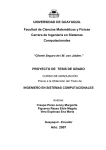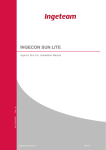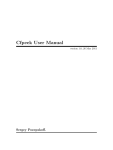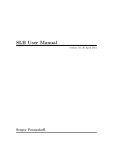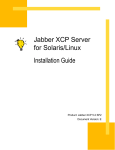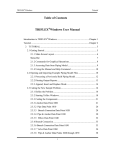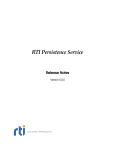Download JOH User Manual
Transcript
JOH User Manual version 1.3, 31 March 2011 Sergey Poznyakoff. c 2011 Sergey Poznyakoff Copyright Permission is granted to copy, distribute and/or modify this document under the terms of the GNU Free Documentation License, Version 1.3 or any later version published by the Free Software Foundation; with no Invariant Sections, with the Front-Cover texts being “JOH User Manual”, and with the Back-Cover Texts as in (a) below. A copy of the license is included in the section entitled “GNU Free Documentation License”. (a) The Back-Cover Text is: “You have freedom to copy and modify this manual, like Free Software.” i Short Contents 1 Introduction . . . . . . . . . . . . . . . . . . . . . . . . . . . . . . . . . . . . . . . . . 1 2 Quick Start . . . . . . . . . . . . . . . . . . . . . . . . . . . . . . . . . . . . . . . . . . 3 3 Johd – Jabber Over HTTP Daemon . . . . . . . . . . . . . . . . . . . . . 11 4 Joh.cgi – Auxiliary CGI Utility . . . . . . . . . . . . . . . . . . . . . . . . . 15 5 How to Report a Bug . . . . . . . . . . . . . . . . . . . . . . . . . . . . . . . . . 17 A GNU Free Documentation License . . . . . . . . . . . . . . . . . . . . . . . 19 Concept Index . . . . . . . . . . . . . . . . . . . . . . . . . . . . . . . . . . . . . . . . . . 27 iii Table of Contents 1 2 Introduction . . . . . . . . . . . . . . . . . . . . . . . . . . . . . . . . . . . . . 1 Quick Start . . . . . . . . . . . . . . . . . . . . . . . . . . . . . . . . . . . . . . 3 2.1 2.2 2.3 2.4 2.5 2.6 3 Configure johd Sockets . . . . . . . . . . . . . . . . . . . . . . . . . . . . . . . . . . . . . . . . . Using JOH in Standalone Mode . . . . . . . . . . . . . . . . . . . . . . . . . . . . . . . . Using JOH in CGI Mode . . . . . . . . . . . . . . . . . . . . . . . . . . . . . . . . . . . . . . . Two Ways to Start johd . . . . . . . . . . . . . . . . . . . . . . . . . . . . . . . . . . . . . . . HTTP GET Requests . . . . . . . . . . . . . . . . . . . . . . . . . . . . . . . . . . . . . . . . . . Logging and Debugging . . . . . . . . . . . . . . . . . . . . . . . . . . . . . . . . . . . . . . . . 3 5 6 6 8 9 Johd – Jabber Over HTTP Daemon . . . . . . . . . 11 3.1 3.2 3.3 URLs . . . . . . . . . . . . . . . . . . . . . . . . . . . . . . . . . . . . . . . . . . . . . . . . . . . . . . . . . 12 Exit Codes . . . . . . . . . . . . . . . . . . . . . . . . . . . . . . . . . . . . . . . . . . . . . . . . . . . . 13 Signals . . . . . . . . . . . . . . . . . . . . . . . . . . . . . . . . . . . . . . . . . . . . . . . . . . . . . . . . 14 4 Joh.cgi – Auxiliary CGI Utility . . . . . . . . . . . . . . 15 5 How to Report a Bug . . . . . . . . . . . . . . . . . . . . . . . . . 17 Appendix A GNU Free Documentation License . . . . . . . . . . . . . . . . . . . . . . . . . . . . . . . . . . . . . . . . . . . . . . . . 19 A.1 ADDENDUM: How to use this License for your documents . . . . 26 Concept Index . . . . . . . . . . . . . . . . . . . . . . . . . . . . . . . . . . . . . 27 Chapter 1: Introduction 1 1 Introduction Most site administrators use firewalls to protect their network from eventual abuse. Quite often such firewalls do not allow outbound connections to unknown and unused ports, including Jabber client connection port 5222/tcp, which makes it impossible to use Jabber services from inside such firewalls. Several methods have been proposed so far to overcome this difficulty. The most reliable of them is Jabber HTTP Polling 1 , which enables access to Jabber ports via HTTP requests. Yet another method of accessing Jabber via HTTP is HTTP Connect. This method uses the HTTP ‘CONNECT’ command to establish a permanent connection to the remote Jabber server. JOH supports both methods. The name JOH stands for Jabber Over HTTP. The package provides an easy to use proxy server for Jabber connections. It is intended for use by system administrators who wish to provide access to their Jabber serves via HTTP for those users who happen to be behind strict firewalls. 1 See http://xmpp.org/extensions/xep-0025.html. Chapter 2: Quick Start 3 2 Quick Start There are two most common scenarios for configuring Jabber Over HTTP proxy. In the first scenario, you have a dedicated Jabber server and the port 80 (HTTP) is not used on that server. In this case you will use standalone mode. In this mode johd is configured to listen on port 80 to proxy incoming requests to your Jabber server and vice-versa. In the second scenario, the port 80 is already in use by an HTTP server running on the same box as your Jabber server. For such cases, JOH provides a CGI mode. In this mode, you start johd to listen on an auxiliary port, and configure your HTTP server to run a CGI program, joh.cgi, which is included in the package. The system then works as follows. HTTP polling requests are received by your HTTP server, which invokes joh.cgi to handle them, In its turn, joh.cgi extracts the necessary data from each request, reformats it and sends it over to the johd daemon over the auxiliary port. When a subsequent request arrives, joh.cgi receives the reply from johd, formats it as a HTTP response and sends it back to the HTTP server, which sends it to the requesting client. The CGI mode works only with HTTP Polling. Of course, there may be combined cases, e.g.: • You run HTTP and Jabber servers on separate boxes, but wish your HTTP server to handle polling requests for your Jabber server. In such cases, you would also use the CGI mode. The joh.cgi would be installed on the HTTP server and johd on the Jabber server. • You wish to use a standalone machine as Jabber proxy. In this case you would use johd in standalone mode on this machine and configure it to communicate with your main Jabber server. 2.1 Configure johd Sockets Johd reads its configuration from the command line. Only the traditional short options are used. The order in which you place options is important: some of them affect others that appear further in the command line. The ‘-l’ option configures a socket to listen on (hence its mnemonics: listen). Its argument is an URL or address specification for the socket. Normally, this specification is the desired IP address and port number, separated by a colon. For example, to have johd listen on IP address 127.0.0.1, port 1111, you would write: johd -l 127.0.0.1:1111 If you wish it to listen on a given port on all configured network interfaces, just specify that port alone, without a specific IP address, as in: johd -l 1111 4 JOH User Manual In fact, Johd is able to work with three distinct socket families: UNIX sockets, IPv4 and IPv6 inet addresses. There are various ways to specify these. For a detailed discussion of them, see Section 3.1 [URLs], page 12. Any number of ‘-l’ options can be given: johd will open all required sockets and will listen for connections on any of them. The important point is the class of the socket to open. As you already know, johd works with two distinct socket classes: HTTP sockets, which are supposed to receive data formatted in accordance with the HTTP protocol, and auxiliary CGI sockets, which are designed to communicate with joh.cgi. By default, the latter is assumed1 . The class of the socket to open is changed by the ‘-c’ command line option: ‘-c HTTP’ tells johd to open all subsequent sockets for listening on HTTP requests, and ‘-c CGI’ instructs it to open them for handling internal CGI protocol data. The ‘-c’ option affects all ‘-l’ options that appear to the right of it in the command line, until another ‘-c’ option is encountered, which changes the default. To illustrate this, consider the following invocation: johd -l 127.0.0.1:1111 \ -c HTTP -l 10.10.0.1 -l 192.168.0.2 \ -c CGI 10.10.0.1 It opens two sockets for auxiliary CGI: one at 127.0.0.1:1111 (it appeared before the first ‘-c’ option and therefore belongs to the default class, which is ‘CGI’) and the other at 10.10.0.1, which appears after an explicit ‘-c CGI’. Notice that this later has no port specification. If the port is missing. johd will select the default port for this class. The default port for ‘CGI’ is 11002 , and the default for ‘HTTP’ is, of course, 80. Therefore, the command above will listen for HTTP requests on 10.10.0.1:80 and 192.168.0.2:80. Each incoming connection is validated via TCP wrappers 3 . The default daemon (or service) name for validation coincides with the name johd was invoked with (i.e. is ‘johd’, unless you renamed the program or started it via a symlink). However, the validation rules will most probably depend on the class of socket that received the connection: internal ‘CGI’ sockets in most cases should not be visible outside your host, whereas ‘HTTP’ ones should be accessible to everybody, Therefore, a special option is provided, which changes the TCP wrapper service name for subsequent sockets. This is the ‘-S’ option (mnemonics: Service name). Similarly to ‘-c’, the ‘-S’ 1 2 3 The decision which class to take as the default is somehow arbitrary, we might as well have chosen HTTP, but historically it happened to be CGI. Again, the choice was somewhat arbitrary, but we know of no other service using this number. See Section “ACCESS CONTROL FILES” in hosts access(5) man page, for detailed description of TCP wrapper access control files. Note also, that this feature can be disabled at compile time, by the ‘--without-tcp-wrappers’ option to configure, although this is highly unrecommended. Chapter 2: Quick Start 5 option affects all ‘-l’ options to the right of it, until another ‘-S’ option or end of the command line is encountered, whichever occurs first. Now, let’s illustrate this by an improved version the example above: johd -l 127.0.0.1:1111 \ -S johd-http -c HTTP -l 10.10.0.1 -l 192.168.0.2 \ -s johd-cgi -c CGI 10.10.0.1 In this configuration, the 127.0.0.1:1111 socket will be protected by the TCP service name ‘johd’, the two ‘HTTP’ sockets — by service name ‘johd-http’ and the ‘CGI’ socket 10.10.0.1 — by service name ‘johd-cgi’. Connections to remote Jabber servers are also validated using TCP wrappers. However, they use different service name. The service name for validating a requested jabber connection is created using the following pattern: srvname /jabber@ipaddr where srvname is the TCP service name, as described above, and ipaddr is the IP address of the server. 2.2 Using JOH in Standalone Mode Configuring johd to work in standalone mode is pretty straightforward: all you have to do is give it an address (or addresses) to listen on and instruct it to open these addresses in ‘HTTP’ class. In a simplest case, the following command will do: johd -c HTTP It will instruct johd to listen on port 80 on all configured network interfaces. To select a particular address or addresses to listen on, use the ‘-l’ option, as described in the previous section. It is important to configure your ‘/etc/hosts.allow’ to control accesses to the incoming HTTP port and outgoing Jabber connections. For example, the two lines below allow access to HTTP from anywhere and grant anybody the right to request any Jabber servers: johd: ALL johd/jabber@ALL: ALL As a more complex example, the entries below allow access to HTTP from anywhere and limit the use of Jabber servers to 208.68.163.220 and 192.168.10.1. The use of 208.68.163.220 is granted to anybody, and the use of 192.168.10.1 is allowed only for clients coming from IP addresses in the range 192.168.0.1 — 192.168.0.254. johd: ALL johd/[email protected]: ALL johd/[email protected]: 192.168.10.0/24 6 JOH User Manual 2.3 Using JOH in CGI Mode The ‘CGI’ mode is a bit more complicated, because it involves configuring two components. However, the default settings are chosen so as to simplify the configuration. First, select the socket to use for interprocess communication between johd and joh.cgi. If both processes run on the same box, then ‘localhost’ or some UNIX socket is a natural choice. Now, start the daemon: johd -l 127.0.0.1 Make sure the socket 127.0.0.1:1100 is accessible from localhost. In particular, if your ‘/etc/hosts.deny’ contains the line ‘ALL: ALL’, place this in your ‘/etc/hosts.allow’: johd: 127.0.0.1 Similarly, make sure outgoing connections to selected Jabber servers are allowed for localhost: johd/[email protected]: 127.0.0.1 Then copy joh.cgi to your ‘cgi-bin’ directory and you’re done. You might also wish to configure your HTTP server to use some good-looking alias for that. For example, in my Apache configuration I use: Alias /http-poll /var/www/cgi-bin/joh.cgi If your HTTP server and johd are running on different machines, you will need to inform joh.cgi about the address johd is listening on. Suppose, for example, that johd is running on machine ‘A’ and is listening on IP address 192.168.0.1, port 1100. The HTTP server is running on the machine ‘B’, which has IP address 192.168.0.2. To tell joh.cgi it must connect to ‘192.168.0.1:1100’, set the environment variable JOH_SERVER_URL. For example, if ‘B’ is running Apache, then in your ‘httpd.conf’ you would set: SetEnv JOH_SERVER_URL 192.168.0.1:1100 Notice also, that you need to ensure that this socket on the box ‘A’ is accessible only to 192.168.0.2. For example: 1. In ‘/etc/hosts.deny’: johd: ALL 2. In ‘/etc/hosts.allow’: johd: 192.168.0.2 2.4 Two Ways to Start johd One of the basic assumptions made when designing johd was that it was to be run as a transport within Jabber configuration. Therefore, after startup, johd remains in the foreground and does not disconnect from the controlling terminal. It also normally sends all its diagnostic messages to the standard error output (but see Section 2.6 [logging], page 9, below. To start jabber2 components we recommend using GNU Pies, instead of the default simple program manager shipped with Jabberd2. Pies of- Chapter 2: Quick Start 7 fers considerable flexibility in handling jabber components. For a detailed description of Pies, Section “Top” in GNU Pies Manual. For an example of Jabberd2 configuration with Pies, refer to http://www.gnu.org.ua/ software/pies/example.php?what=jabberd2. To configure Pies to start johd, add the following component statement to your configuration file: component johd { command "johd options "; strderr syslog err; }; Replace johd with the full pathname of the johd binary, and options with the desired command line options. For example: component johd { command "/usr/sbin/johd -c HTTP"; strderr syslog err; }; Another way to start johd is independently of the Jabber server. To do so, give it the ‘-D’ command line option. This option instructs johd to disconnect from the controlling terminal and run in the background as a daemon. Diagnostic messages are then sent to the syslog, using the ‘daemon’ facility (this can be changed using the ‘-F’ option; see Section 2.6 [logging], page 9). Normally, johd continues its operation with the privileges of the user who started it. If this user is root, you may wish johd to run as some other user. To do so, use the ‘-u’ option, e.g.: johd -cHTTP -D -u nobody The daemon switches to new user after completing operations that require root privileges, such as, e.g. creating sockets that listen on ports below 1024, etc. When starting johd in daemon mode, it is also common to give it the ‘-p’ option. This option takes a file name as argument and causes the program to write its PID to that file after switching to the background. If this file already exists, johd will read the PID from it and will check if a process with that PID is actually running. If so, johd refuses to startup and outputs an appropriate diagnostics. Otherwise, it will overwrite the file with the new PID value. If both ‘-u’ and ‘-p’ are used, the pidfile is opened after switching to the user provileges. In this case, you should make sure the directory component of the pidfile is writable for the user supplied with the ‘-u’ option. Following is an example startup command: johd -D -p /var/run/johd.pid To automate startup and shutdown of johd in daemon mode, use the following shell script: 8 JOH User Manual #! /bin/sh PIDFILE=/var/run/johd.pid case $1 in start) /usr/bin/johd -D -p $PIDFILE;; stop) test -f $PIDFILE && kill -TERM ‘cat $PIDFILE‘;; restart) $0 stop $0 start;; *) echo >&2 "usage: $0 {start|stop|restart}" esac 2.5 HTTP GET Requests Proxying of Jabber connections is requested by HTTP requests with either ‘POST’ or ‘CONNECT’ methods. Any other requests received by johd are normally dropped. However, ‘GET’ requests are handled separately. Normally, an incoming ‘GET’ request means that someone has pointed his web browser to the URL served by johd. When such a request arrives, johd replies with a 404 response code. A compiled-in error page is sent back in the response. This behavior can be customized in two ways. First, you can supply a custom error page using the ‘-E’ command line option. The argument to this option must specify an absolute pathname to a valid HTML file. The contents of this file will be sent back in 404 responses. Similarly to ‘-c’ and ‘-S’ options, the ‘-E’ option applies to all HTTP sockets created by subsequent ‘-l’ options which appear to the right of it, until another ‘-E’ or ‘-R’ option (see below) is encountered. An example usage follows: johd -c HTTP -E /etc/joh/404.html -l 10.10.10.1 Another way to handle ‘GET’ requests is to return a 303 response, redirecting the requester to another HTTP resource. This is achieved via the ‘-R’ option. Its argument is a valid URL, beginning with a ‘http://’. For example: johd -c HTTP -R http://www.example.net/jabber Notice, that ‘-E’ and ‘-R’ options are mutually exclusive. For example, the following invocation will reply to ‘GET’ requests arriving to ‘10.10.10.1’ with the error page read from ‘/etc/joh/404.html’, and will redirect any ‘GET’ request arriving to ‘10.10.10.2’ to http://www.example.net/jabber: johd -c HTTP -E /etc/joh/404.html -l 10.10.10.1 \ -R http://www.example.net/jabber -l 10.10.10.2 The ‘joh.cgi’ utility provides similar features, except that it cannot send back a ‘404’ response. Chapter 2: Quick Start 9 If any request other than ‘POST’ arrives, ‘joh.cgi’ replies with the compiled-in error page, just as johd does. If the JOH_ERROR_PAGE environment variable is set, and its value points to a readable file, this file’s contents is sent back instead. If JOH_ERROR_REDIRECT variable is set and its value is a URL which begins with ‘http://’, joh.cgi responds with a redirection to that URL. 2.6 Logging and Debugging Normally, johd prints any errors, warnings and other diagnostic messages on standard error. You can, however, change this default and direct all diagnostic messages to syslog. To do so, specify the desired syslog facility with the ‘-F’ command line option. For example: johd -F daemon Allowed facility names for use with this option are: ‘user’, ‘daemon’, ‘auth’, ‘authpriv’, ‘mail’, ‘cron’, ‘local0’ through ‘local7’. All names are case-insensitive. Notice, that when given the ‘-D’ option (see [daemon], page 7), johd automatically assumes ‘-F daemon’, so you need not use the ‘-F’ option, unless, of course, you want to change the default facility. Messages sent to syslog are prefixed by the program name. To change this prefix use the ‘-L’ option. Its argument will be used as a log tag to prefix each message with. Each diagnostic message has a severity level associated with it. Severity levels are (in order of increasing severity): ‘debug’, ‘warning’, ‘info’, ‘error’, and ‘crit’. The latter is assigned to conditions which cause immediate termination of the program. Normally, severity levels are not printed. To instruct johd to precede each message with its severity level, use the ‘-P’ option. Debugging diagnostics is useful when you trace some difficult configuration problem or investigate a bug in johd itself. This diagnostics is printed only when the ‘-d’ option is given. The argument to the ‘-d’ option is the debugging level, an integer number ranging from 0 to 100. Level 0 effectively disables all debugging and is equivalent to not specifying ‘-d’ option at all. Subsequent levels produce increasing amount of debugging information. Finally, the level 100 prints dumps of network packets received and sent by johd. Notice, that the use of the ‘-d’ option with levels greater than 10 requires a good knowledge about johd internals and slows down its operation, so use it sparingly, if at all. When debugging johd it may be helpful to know where precisely in the source code each debugging message was generated. This information can be obtained using the ‘-i’ (source-info) option. When it is given, each debug 10 JOH User Manual message is additionally prefixed with the name of the source file and line number in it. Chapter 3: Johd – Jabber Over HTTP Daemon 11 3 Johd – Jabber Over HTTP Daemon The following table summarizes the available command line options in alphabetic order. For each option, it provides a reference to the place in the tutorial where the option is discussed. ‘-c class ’ Sets socket class. Allowed values for class are ‘CGI’ and ‘HTTP’. This option affects all subsequent ‘-l’ options appearing to the right of it, until another ‘-c’ option or end of command line is encountered, whichever occurs first. See [socket class], page 4. ‘-D’ After startup, switch to the background and run as daemon. See [daemon], page 7. ‘-d number ’ Sets debugging level. See Section 2.6 [logging], page 9. ‘-E file ’ Read the 404 error page from file. This error page is returned as a response to HTTP GET requests. The file must contain a valid HTML document without external references in the ‘head’ section. See Section 2.5 [get], page 8. This option affects all HTTP sockets created by subsequent ‘-l’ options which appear to the right of it, until another ‘-E’ option or end of command line is encountered, whichever occurs first. ‘-F facility ’ Sets syslog facility. Allowed values for facility are: ‘user’, ‘daemon’, ‘auth’, ‘authpriv’, ‘mail’, ‘cron’, ‘local0’ through ‘local7’. All names are case-insensitive. See Section 2.6 [logging], page 9. ‘-h’ Shows a terse help summary. ‘-i’ Show source line information with debug messages. Section 2.6 [logging], page 9. See ‘-L string ’ Sets log tag. See Section 2.6 [logging], page 9. ‘-l url ’ Listen on the given url. Several ‘-l’ options can appear in the command line. See [listen option], page 3. ‘-P’ Prefix diagnostic messages with their severity level. Section 2.6 [logging], page 9. ‘-p file ’ Write PID to file. See [daemon], page 7. See 12 JOH User Manual ‘-R url ’ Redirect HTTP GET requests to url. The argument must begin with ‘http://’. See Section 2.5 [get], page 8. This option affects all HTTP sockets created by subsequent ‘-l’ options which appear to the right of it, until another ‘-R’ option or end of command line is encountered, whichever occurs first. ‘-S name ’ Sets service name for TCP wrappers. This option affects all subsequent ‘-l’ options appearing to the right of it, until another ‘-S’ option or end of command line is encountered, whichever occurs first. See [TCP wrappers], page 4. ‘-s url ’ Sets URL of the default jabber server. It is used if the request does not specify the server explicitly. ‘-t type :timeout ’ Sets session idle timeout. Type is the type of the socket: ‘C’ for client sockets (either ‘CGI’ or ‘HTTP’) and ‘J’ for Jabber socket. Timeout is the timeout value, either in seconds or in ‘X hY mZ s’ form. Defaults are: ‘-t C:5m -t J:1m’. ‘-u user ’ Run as user, after completing privileged operations, such as creating sockets that listen on ports below 1024. See [daemon], page 7. ‘-V’ Prints the program version. 3.1 URLs JOH components are able to handle three socket families: UNIX sockets, IPv4 and IPv6. URLs provide a uniform way of specifying socket addresses in any of these families. A URL consists of the following parts: scheme ://adress :port Up to two parts can be omitted, if that does not create ambiguity. Valid URL schemes are: unix Specifies a UNIX socket. The address part is the socket pathname, and the ‘:port ’ part is not used. The pathname must be absolute, e.g. ‘unix:///var/run/joh.socket’. To facilitate typing, the two slashes after the colon can be omitted, as in: unix:/var/run/joh.socket inet Specifies an IPv4 socket. The address part must be an IPv4 address in dotted quad form, or a host name. If the latter resolves to multiple addresses, those belonging to the IPv4 family Chapter 3: Johd – Jabber Over HTTP Daemon 13 are selected. The port part is either the network port number in decimal, or a corresponding service name from ‘/etc/services’. For example: inet://127.0.0.1:1100 inet6 Specifies an IPv6 socket. The address part must be either an IPv6 address in numeric notation enclosed in square brackets or a host name. If the latter resolves to multiple addresses, those belonging to the IPv6 family are selected. The port part is either the network port number in decimal, or a corresponding service name from ‘/etc/services’. E.g.: inet6://[::1]:1100 For URLs given as argument to the ‘-l’ option, either address or port can be omitted. If address is omitted, the program will listen on all available network interfaces with addresses from the specified family, e.g.: inet6://:1100 instructs johd to listen on port 1100 on all IPv6 interfaces. If port is omitted, the default is selected depending upon the class of the socket: 1100 is used for ‘CGI’ sockets, and 80 is used for ‘HTTP’ sockets. The port component can also be omitted in URLs which are arguments to the ‘-s’ option (see [default jabber server], page 12). In this case, port defaults to 5222, e.g.: inet6://[::1] inet://127.0.0.1 For compatibility with earlier versions, johd accepts IPv6 addresses without square brackets, although such use is not recommended, e.g.: inet6://::1:1100 If the scheme part is omitted, johd tries to do its best to guess what address family is assumed. Thus: ‘/var/run/socket’ is treated as ‘unix:///var/run/socket’; ‘127.0.0.1’ is treated as ‘inet://127.0.0.1’; ‘[::1]:3398’ is treated as ‘inet6://[::1]:3398’; ‘::1:3398’ is treated as ‘inet6://[::1]:3398’; The URL ‘3456’ causes johd to listen on port 3456 on all available network interfaces, no matter what their address family is. 3.2 Exit Codes Depending on the reason for termination, johd exits with the following codes: 0 Normal termination. ‘SIGTERM’ signal. This includes, e.g., termination on 64 Usage error, e.g. unknown option or erroneous argument was given in the command line. 14 JOH User Manual 69 A service is unavailable. This happens, for instance, if the program could not fork or disconnect from the controlling terminal. 70 An internal software error has been detected. If it ever happens, please report this as bug. See Chapter 5 [Reporting Bugs], page 17. 75 Temporary error condition. Currently this happens if the ‘-p file ’ option is specified, file exists, but cannot be accessed. 78 A configuration error occurred. This is different from usage error (64) in that the data supplied to the program where syntactically correct, but cannot be used. For example, a host name supplied with ‘-l’ cannot be resolved. 3.3 Signals The following signals cause immediate program termination with exit code 0: ‘SIGPIPE’, ‘SIGINT’, ‘SIGQUIT’, ‘SIGTERM’, ‘SIGHUP’. Chapter 4: Joh.cgi – Auxiliary CGI Utility 15 4 Joh.cgi – Auxiliary CGI Utility If you need to run johd on a box which already runs an HTTP server, it is impossible to have johd handle HTTP connections directly, because port 80 is already in use. The solution then is to use joh.cgi within your HTTP server and to start johd in CGI mode. This approach is discussed in detail in Section 2.3 [cgi], page 6. The usual way to run joh.cgi is to copy it to your ‘cgi-bin’ directory and to provide an alias for it. For example, in Apache ‘httpd.conf’: Alias /http-poll /var/www/cgi-bin/joh.cgi The built-in default configuration is sufficient for most cases. If, however, you need to configure joh.cgi, you can do so via the following environment variables: JOH_SERVER_URL Sets the URL of the johd server. Default is ‘127.0.0.1:1100’. JOH_JABBER_SERVER_URL Sets the URL of the default Jabber server. This value is used when the incoming HTTP request does not specify server and port explicitly. The default value is ‘inet://gnu.org.ua’. JOH_JABBER_SERVER Specifies the IP address of the default Jabber server. JOH_JABBER_PORT Sets the port name of the default Jabber server. JOH_ERROR_PAGE If any request other than ‘POST’ arrives, return the contents of the file specified in the value of this variable. See [joh.cgi bad request handling], page 8. JOH_ERROR_REDIRECT If any request other than ‘POST’ arrives, redirect it to the URL supplied in this variable. See [joh.cgi bad request handling], page 8. Chapter 5: How to Report a Bug 17 5 How to Report a Bug Please, report bugs and suggestions to [email protected]. You hit a bug if at least one of the conditions below is met: • johd of joh.cgi terminate on signal 11 (SIGSEGV) or 6 (SIGABRT). • johd terminates with exit code 70 (internal software error) • Either of the components fails to do its job as described in this manual. If you think you’ve found a bug, please be sure to include maximum information available to reliably reproduce it, or at least to analyze it. The information needed is: • Version of the package you are using. • Compilation options used when configuring the package. • Command line options used. • Conditions under which the bug appears. Any errors, typos or omissions found in this manual also qualify as bugs. Please report them, if you happen to find any. Appendix A: GNU Free Documentation License 19 Appendix A GNU Free Documentation License Version 1.2, November 2002 c 2000,2001,2002 Free Software Foundation, Inc. Copyright 59 Temple Place, Suite 330, Boston, MA 02111-1307, USA Everyone is permitted to copy and distribute verbatim copies of this license document, but changing it is not allowed. 0. PREAMBLE The purpose of this License is to make a manual, textbook, or other functional and useful document free in the sense of freedom: to assure everyone the effective freedom to copy and redistribute it, with or without modifying it, either commercially or noncommercially. Secondarily, this License preserves for the author and publisher a way to get credit for their work, while not being considered responsible for modifications made by others. This License is a kind of “copyleft”, which means that derivative works of the document must themselves be free in the same sense. It complements the GNU General Public License, which is a copyleft license designed for free software. We have designed this License in order to use it for manuals for free software, because free software needs free documentation: a free program should come with manuals providing the same freedoms that the software does. But this License is not limited to software manuals; it can be used for any textual work, regardless of subject matter or whether it is published as a printed book. We recommend this License principally for works whose purpose is instruction or reference. 1. APPLICABILITY AND DEFINITIONS This License applies to any manual or other work, in any medium, that contains a notice placed by the copyright holder saying it can be distributed under the terms of this License. Such a notice grants a world-wide, royalty-free license, unlimited in duration, to use that work under the conditions stated herein. The “Document”, below, refers to any such manual or work. Any member of the public is a licensee, and is addressed as “you”. You accept the license if you copy, modify or distribute the work in a way requiring permission under copyright law. A “Modified Version” of the Document means any work containing the Document or a portion of it, either copied verbatim, or with modifications and/or translated into another language. A “Secondary Section” is a named appendix or a front-matter section of the Document that deals exclusively with the relationship of the publishers or authors of the Document to the Document’s overall subject (or to related matters) and contains nothing that could fall directly within 20 JOH User Manual that overall subject. (Thus, if the Document is in part a textbook of mathematics, a Secondary Section may not explain any mathematics.) The relationship could be a matter of historical connection with the subject or with related matters, or of legal, commercial, philosophical, ethical or political position regarding them. The “Invariant Sections” are certain Secondary Sections whose titles are designated, as being those of Invariant Sections, in the notice that says that the Document is released under this License. If a section does not fit the above definition of Secondary then it is not allowed to be designated as Invariant. The Document may contain zero Invariant Sections. If the Document does not identify any Invariant Sections then there are none. The “Cover Texts” are certain short passages of text that are listed, as Front-Cover Texts or Back-Cover Texts, in the notice that says that the Document is released under this License. A Front-Cover Text may be at most 5 words, and a Back-Cover Text may be at most 25 words. A “Transparent” copy of the Document means a machine-readable copy, represented in a format whose specification is available to the general public, that is suitable for revising the document straightforwardly with generic text editors or (for images composed of pixels) generic paint programs or (for drawings) some widely available drawing editor, and that is suitable for input to text formatters or for automatic translation to a variety of formats suitable for input to text formatters. A copy made in an otherwise Transparent file format whose markup, or absence of markup, has been arranged to thwart or discourage subsequent modification by readers is not Transparent. An image format is not Transparent if used for any substantial amount of text. A copy that is not “Transparent” is called “Opaque”. Examples of suitable formats for Transparent copies include plain ascii without markup, Texinfo input format, LaTEX input format, SGML or XML using a publicly available DTD, and standard-conforming simple HTML, PostScript or PDF designed for human modification. Examples of transparent image formats include PNG, XCF and JPG. Opaque formats include proprietary formats that can be read and edited only by proprietary word processors, SGML or XML for which the DTD and/or processing tools are not generally available, and the machine-generated HTML, PostScript or PDF produced by some word processors for output purposes only. The “Title Page” means, for a printed book, the title page itself, plus such following pages as are needed to hold, legibly, the material this License requires to appear in the title page. For works in formats which do not have any title page as such, “Title Page” means the text near the most prominent appearance of the work’s title, preceding the beginning of the body of the text. Appendix A: GNU Free Documentation License 21 A section “Entitled XYZ” means a named subunit of the Document whose title either is precisely XYZ or contains XYZ in parentheses following text that translates XYZ in another language. (Here XYZ stands for a specific section name mentioned below, such as “Acknowledgements”, “Dedications”, “Endorsements”, or “History”.) To “Preserve the Title” of such a section when you modify the Document means that it remains a section “Entitled XYZ” according to this definition. The Document may include Warranty Disclaimers next to the notice which states that this License applies to the Document. These Warranty Disclaimers are considered to be included by reference in this License, but only as regards disclaiming warranties: any other implication that these Warranty Disclaimers may have is void and has no effect on the meaning of this License. 2. VERBATIM COPYING You may copy and distribute the Document in any medium, either commercially or noncommercially, provided that this License, the copyright notices, and the license notice saying this License applies to the Document are reproduced in all copies, and that you add no other conditions whatsoever to those of this License. You may not use technical measures to obstruct or control the reading or further copying of the copies you make or distribute. However, you may accept compensation in exchange for copies. If you distribute a large enough number of copies you must also follow the conditions in section 3. You may also lend copies, under the same conditions stated above, and you may publicly display copies. 3. COPYING IN QUANTITY If you publish printed copies (or copies in media that commonly have printed covers) of the Document, numbering more than 100, and the Document’s license notice requires Cover Texts, you must enclose the copies in covers that carry, clearly and legibly, all these Cover Texts: Front-Cover Texts on the front cover, and Back-Cover Texts on the back cover. Both covers must also clearly and legibly identify you as the publisher of these copies. The front cover must present the full title with all words of the title equally prominent and visible. You may add other material on the covers in addition. Copying with changes limited to the covers, as long as they preserve the title of the Document and satisfy these conditions, can be treated as verbatim copying in other respects. If the required texts for either cover are too voluminous to fit legibly, you should put the first ones listed (as many as fit reasonably) on the actual cover, and continue the rest onto adjacent pages. If you publish or distribute Opaque copies of the Document numbering more than 100, you must either include a machine-readable Transparent copy along with each Opaque copy, or state in or with each Opaque 22 JOH User Manual copy a computer-network location from which the general network-using public has access to download using public-standard network protocols a complete Transparent copy of the Document, free of added material. If you use the latter option, you must take reasonably prudent steps, when you begin distribution of Opaque copies in quantity, to ensure that this Transparent copy will remain thus accessible at the stated location until at least one year after the last time you distribute an Opaque copy (directly or through your agents or retailers) of that edition to the public. It is requested, but not required, that you contact the authors of the Document well before redistributing any large number of copies, to give them a chance to provide you with an updated version of the Document. 4. MODIFICATIONS You may copy and distribute a Modified Version of the Document under the conditions of sections 2 and 3 above, provided that you release the Modified Version under precisely this License, with the Modified Version filling the role of the Document, thus licensing distribution and modification of the Modified Version to whoever possesses a copy of it. In addition, you must do these things in the Modified Version: A. Use in the Title Page (and on the covers, if any) a title distinct from that of the Document, and from those of previous versions (which should, if there were any, be listed in the History section of the Document). You may use the same title as a previous version if the original publisher of that version gives permission. B. List on the Title Page, as authors, one or more persons or entities responsible for authorship of the modifications in the Modified Version, together with at least five of the principal authors of the Document (all of its principal authors, if it has fewer than five), unless they release you from this requirement. C. State on the Title page the name of the publisher of the Modified Version, as the publisher. D. Preserve all the copyright notices of the Document. E. Add an appropriate copyright notice for your modifications adjacent to the other copyright notices. F. Include, immediately after the copyright notices, a license notice giving the public permission to use the Modified Version under the terms of this License, in the form shown in the Addendum below. G. Preserve in that license notice the full lists of Invariant Sections and required Cover Texts given in the Document’s license notice. H. Include an unaltered copy of this License. I. Preserve the section Entitled “History”, Preserve its Title, and add to it an item stating at least the title, year, new authors, and publisher of the Modified Version as given on the Title Page. If Appendix A: GNU Free Documentation License 23 there is no section Entitled “History” in the Document, create one stating the title, year, authors, and publisher of the Document as given on its Title Page, then add an item describing the Modified Version as stated in the previous sentence. J. Preserve the network location, if any, given in the Document for public access to a Transparent copy of the Document, and likewise the network locations given in the Document for previous versions it was based on. These may be placed in the “History” section. You may omit a network location for a work that was published at least four years before the Document itself, or if the original publisher of the version it refers to gives permission. K. For any section Entitled “Acknowledgements” or “Dedications”, Preserve the Title of the section, and preserve in the section all the substance and tone of each of the contributor acknowledgements and/or dedications given therein. L. Preserve all the Invariant Sections of the Document, unaltered in their text and in their titles. Section numbers or the equivalent are not considered part of the section titles. M. Delete any section Entitled “Endorsements”. Such a section may not be included in the Modified Version. N. Do not retitle any existing section to be Entitled “Endorsements” or to conflict in title with any Invariant Section. O. Preserve any Warranty Disclaimers. If the Modified Version includes new front-matter sections or appendices that qualify as Secondary Sections and contain no material copied from the Document, you may at your option designate some or all of these sections as invariant. To do this, add their titles to the list of Invariant Sections in the Modified Version’s license notice. These titles must be distinct from any other section titles. You may add a section Entitled “Endorsements”, provided it contains nothing but endorsements of your Modified Version by various parties— for example, statements of peer review or that the text has been approved by an organization as the authoritative definition of a standard. You may add a passage of up to five words as a Front-Cover Text, and a passage of up to 25 words as a Back-Cover Text, to the end of the list of Cover Texts in the Modified Version. Only one passage of Front-Cover Text and one of Back-Cover Text may be added by (or through arrangements made by) any one entity. If the Document already includes a cover text for the same cover, previously added by you or by arrangement made by the same entity you are acting on behalf of, you may not add another; but you may replace the old one, on explicit permission from the previous publisher that added the old one. 24 JOH User Manual The author(s) and publisher(s) of the Document do not by this License give permission to use their names for publicity for or to assert or imply endorsement of any Modified Version. 5. COMBINING DOCUMENTS You may combine the Document with other documents released under this License, under the terms defined in section 4 above for modified versions, provided that you include in the combination all of the Invariant Sections of all of the original documents, unmodified, and list them all as Invariant Sections of your combined work in its license notice, and that you preserve all their Warranty Disclaimers. The combined work need only contain one copy of this License, and multiple identical Invariant Sections may be replaced with a single copy. If there are multiple Invariant Sections with the same name but different contents, make the title of each such section unique by adding at the end of it, in parentheses, the name of the original author or publisher of that section if known, or else a unique number. Make the same adjustment to the section titles in the list of Invariant Sections in the license notice of the combined work. In the combination, you must combine any sections Entitled “History” in the various original documents, forming one section Entitled “History”; likewise combine any sections Entitled “Acknowledgements”, and any sections Entitled “Dedications”. You must delete all sections Entitled “Endorsements.” 6. COLLECTIONS OF DOCUMENTS You may make a collection consisting of the Document and other documents released under this License, and replace the individual copies of this License in the various documents with a single copy that is included in the collection, provided that you follow the rules of this License for verbatim copying of each of the documents in all other respects. You may extract a single document from such a collection, and distribute it individually under this License, provided you insert a copy of this License into the extracted document, and follow this License in all other respects regarding verbatim copying of that document. 7. AGGREGATION WITH INDEPENDENT WORKS A compilation of the Document or its derivatives with other separate and independent documents or works, in or on a volume of a storage or distribution medium, is called an “aggregate” if the copyright resulting from the compilation is not used to limit the legal rights of the compilation’s users beyond what the individual works permit. When the Document is included an aggregate, this License does not apply to the other works in the aggregate which are not themselves derivative works of the Document. If the Cover Text requirement of section 3 is applicable to these copies of the Document, then if the Document is less than one half of the entire Appendix A: GNU Free Documentation License 25 aggregate, the Document’s Cover Texts may be placed on covers that bracket the Document within the aggregate, or the electronic equivalent of covers if the Document is in electronic form. Otherwise they must appear on printed covers that bracket the whole aggregate. 8. TRANSLATION Translation is considered a kind of modification, so you may distribute translations of the Document under the terms of section 4. Replacing Invariant Sections with translations requires special permission from their copyright holders, but you may include translations of some or all Invariant Sections in addition to the original versions of these Invariant Sections. You may include a translation of this License, and all the license notices in the Document, and any Warranty Disclaimers, provided that you also include the original English version of this License and the original versions of those notices and disclaimers. In case of a disagreement between the translation and the original version of this License or a notice or disclaimer, the original version will prevail. If a section in the Document is Entitled “Acknowledgements”, “Dedications”, or “History”, the requirement (section 4) to Preserve its Title (section 1) will typically require changing the actual title. 9. TERMINATION You may not copy, modify, sublicense, or distribute the Document except as expressly provided for under this License. Any other attempt to copy, modify, sublicense or distribute the Document is void, and will automatically terminate your rights under this License. However, parties who have received copies, or rights, from you under this License will not have their licenses terminated so long as such parties remain in full compliance. 10. FUTURE REVISIONS OF THIS LICENSE The Free Software Foundation may publish new, revised versions of the GNU Free Documentation License from time to time. Such new versions will be similar in spirit to the present version, but may differ in detail to address new problems or concerns. See http://www.gnu.org/copyleft/. Each version of the License is given a distinguishing version number. If the Document specifies that a particular numbered version of this License “or any later version” applies to it, you have the option of following the terms and conditions either of that specified version or of any later version that has been published (not as a draft) by the Free Software Foundation. If the Document does not specify a version number of this License, you may choose any version ever published (not as a draft) by the Free Software Foundation. 26 JOH User Manual A.1 ADDENDUM: How to use this License for your documents To use this License in a document you have written, include a copy of the License in the document and put the following copyright and license notices just after the title page: Copyright (C) year your name . Permission is granted to copy, distribute and/or modify this document under the terms of the GNU Free Documentation License, Version 1.2 or any later version published by the Free Software Foundation; with no Invariant Sections, no Front-Cover Texts, and no Back-Cover Texts. A copy of the license is included in the section entitled ‘‘GNU Free Documentation License’’. If you have Invariant Sections, Front-Cover Texts and Back-Cover Texts, replace the “with...Texts.” line with this: with the Invariant Sections being list their titles , with the Front-Cover Texts being list , and with the Back-Cover Texts being list . If you have Invariant Sections without Cover Texts, or some other combination of the three, merge those two alternatives to suit the situation. If your document contains nontrivial examples of program code, we recommend releasing these examples in parallel under your choice of free software license, such as the GNU General Public License, to permit their use in free software. Concept Index 27 Concept Index This is a general index of all issues discussed in this manual / H /etc/hosts.allow . . . . . . . . . . . . . . . . . . . . . 5 h, -h . . . . . . . . . . . . . . . . . . . . . . . . . . . . . . . . . 11 hosts.allow . . . . . . . . . . . . . . . . . . . . . . . . . . . 5 hosts.allow, CGI sockets . . . . . . . . . . . . . . . . 6 HTTP Connect . . . . . . . . . . . . . . . . . . . . . . . . 1 HTTP Polling . . . . . . . . . . . . . . . . . . . . . . . . . . 1 A alias, HTTP server . . . . . . . . . . . . . . . . . . . . . 6 C c, -c class . . . . . . . . . . . . . . . . . . . . . . . . . . . 11 c, -c option introduced . . . . . . . . . . . . . . . . . 4 cgi mode . . . . . . . . . . . . . . . . . . . . . . . . . . . . . . . 6 CGI mode, defined . . . . . . . . . . . . . . . . . . . . . 3 class, socket . . . . . . . . . . . . . . . . . . . . . . . . . . . . 4 controlling terminal . . . . . . . . . . . . . . . . . . . . 7 D D, -D . . . . . . . . . . . . . . . . . . . . . . . . . . . . . . . . . 11 d, -d number . . . . . . . . . . . . . . . . . . . . . . . . . 11 d, -d option, described. . . . . . . . . . . . . . . 9 D, -D option, introduction . . . . . . . . . . . 7 daemon mode, johd . . . . . . . . . . . . . . . . . . . . 7 daemon name, TCP wrappers . . . . . . . . . . 4 debugging . . . . . . . . . . . . . . . . . . . . . . . . . . . . . . 9 E E, -E file . . . . . . . . . . . . . . . . . . . . . . . . . . . . 11 E, -E option, introduction . . . . . . . . . . . 8 exit codes . . . . . . . . . . . . . . . . . . . . . . . . . . . . . 13 F F, -F facility . . . . . . . . . . . . . . . . . . . . . . . 11 F, -F option, described. . . . . . . . . . . . . . . 9 facility, syslog . . . . . . . . . . . . . . . . . . . . . . . . . . 9 FDL, GNU Free Documentation License . . . . . . . . . . . . . . . . . . . . . . . . . . . . . . . . . . 19 firewall . . . . . . . . . . . . . . . . . . . . . . . . . . . . . . . . . 1 G GNU Pies . . . . . . . . . . . . . . . . . . . . . . . . . . . . . . 6 I i, -i . . . . . . . . . . . . . . . . . . . . . . . . . . . . . . . . . 11 i, -i option described . . . . . . . . . . . . . . . . 9 inet . . . . . . . . . . . . . . . . . . . . . . . . . . . . . . . . . . 12 inet6 . . . . . . . . . . . . . . . . . . . . . . . . . . . . . . . . . 13 IPv4 sockets . . . . . . . . . . . . . . . . . . . . . . . . . . 12 IPv6 sockets . . . . . . . . . . . . . . . . . . . . . . . . . . 13 J jabber2 . . . . . . . . . . . . . . . . . . . . . . . . . . . . . . . . 6 joh.cgi . . . . . . . . . . . . . . . . . . . . . . . . . . . . . . . 15 joh.cgi, described . . . . . . . . . . . . . . . . . . . . . 6 JOH_ERROR_PAGE . . . . . . . . . . . . . . . . . . . . 8, 15 JOH_ERROR_REDIRECT . . . . . . . . . . . . . . . 9, 15 JOH_JABBER_PORT . . . . . . . . . . . . . . . . . . . . . 15 JOH_JABBER_SERVER . . . . . . . . . . . . . . . . . . . 15 JOH_JABBER_SERVER_URL . . . . . . . . . . . . . . 15 JOH_SERVER_URL. . . . . . . . . . . . . . . . . . . . . . . 15 johd . . . . . . . . . . . . . . . . . . . . . . . . . . . . . . . . . . 11 L l, -l option introduced . . . . . . . . . . . . . . . . . . 3 L, -L option, described. . . . . . . . . . . . . . . 9 L, -L string . . . . . . . . . . . . . . . . . . . . . . . . . 11 l, -l url . . . . . . . . . . . . . . . . . . . . . . . . . . . . . 11 log tag . . . . . . . . . . . . . . . . . . . . . . . . . . . . . . . . . 9 P P, -P . . . . . . . . . . . . . . . . . . . . . . . . . . . . . . . . . 11 p, -p file . . . . . . . . . . . . . . . . . . . . . . . . . . . . 11 p, -p option, described. . . . . . . . . . . . . . . 7 P, -P option, described. . . . . . . . . . . . . . . 9 PID . . . . . . . . . . . . . . . . . . . . . . . . . . . . . . . . . . . . 7 pidfile . . . . . . . . . . . . . . . . . . . . . . . . . . . . . . . . . . 7 pies . . . . . . . . . . . . . . . . . . . . . . . . . . . . . . . . . . . . 6 28 JOH User Manual R syslog . . . . . . . . . . . . . . . . . . . . . . . . . . . . . . . . . . 9 R, -R option, introduction . . . . . . . . . . . 8 R, -R url . . . . . . . . . . . . . . . . . . . . . . . . . . . . . 11 S S, -S name . . . . . . . . . . . . . . . . . . . . . . . . . . . . 12 S, -S option introduced . . . . . . . . . . . . . . . . . 4 s, -s url . . . . . . . . . . . . . . . . . . . . . . . . . . . . . 12 service name, TCP wrappers . . . . . . . . . . . 4 severity level . . . . . . . . . . . . . . . . . . . . . . . . . . . 9 signals . . . . . . . . . . . . . . . . . . . . . . . . . . . . . . . . 14 socket class . . . . . . . . . . . . . . . . . . . . . . . . . . . . 4 sockets, johd . . . . . . . . . . . . . . . . . . . . . . . . . . . 3 source location . . . . . . . . . . . . . . . . . . . . . . . . . 9 standalone mode . . . . . . . . . . . . . . . . . . . . . . . 5 standalone mode, defined . . . . . . . . . . . . . . . 3 startup script . . . . . . . . . . . . . . . . . . . . . . . . . . 7 startup, johd . . . . . . . . . . . . . . . . . . . . . . . . . . . 6 T t, -t type :timeout . . . . . . . . . . . . . . . . . . 12 tag, logging . . . . . . . . . . . . . . . . . . . . . . . . . . . . 9 TCP wrappers . . . . . . . . . . . . . . . . . . . . . . . . . 4 U u, -u option, introduction . . . . . . . . . . . 7 u, -u user . . . . . . . . . . . . . . . . . . . . . . . . . . . . 12 UNIX socket . . . . . . . . . . . . . . . . . . . . . . . . . . 12 unix, URL . . . . . . . . . . . . . . . . . . . . . . . . . . . . 12 URL . . . . . . . . . . . . . . . . . . . . . . . . . . . . . . . . . . 12 V V, -V . . . . . . . . . . . . . . . . . . . . . . . . . . . . . . . . . 12



































